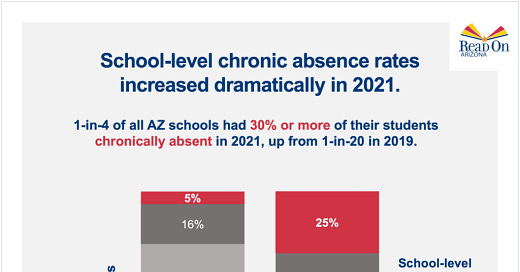The Daily Agenda: Sunnyside grapples with post-pandemic attendance
Sunnyside has seen a spike in student absences in the years following the pandemic ... But it's not just a districtwide problem .... Quick turnaround for older voters.
The days of social distancing and mandatory masking might be in the rearview mirror, but one local school district is still wrestling with the after-effects of the pandemic, as student absences hit an all-time high.
During a Sunnyside Unified School District governing board meeting last month, Chief Academic Officer Pam Betten told board members that districtwide attendance has become a crisis, averaging just 78% for students in 8th through 12th grades.
Before the pandemic, attendance at Desert View High School was averaging between 88 and 90% for those same grades, according to district superintendent and former Desert View High School Principal Jose Gastelum.
In the years since, attendance at Desert View has dropped to around 81%, with Gastelum saying that administrators are especially concerned about absences by 10th graders.
And this isn’t just a Tucson problem. Data from the Arizona Department of Education shows that chronic absenteeism –– missing 10% or more of the school year –– has risen across the state in the years following the pandemic.
Arizona’s rate of chronic absenteeism was 12.7% during the 2018-2019 school year, but more than doubled to 32% in the 2021-2022 school year. It dropped slightly to 28% the following year, but state officials are still concerned.
Last spring, the state’s early literacy initiative, Read On Arizona, created a task force to address the issue, made up of representatives from the governor’s office, school districts, state agencies, community groups and the state Legislature.
The task force is reviewing data, consulting national experts and developing recommendations and resources to prevent chronic absenteeism and help re-engage students and families. Read on Arizona said that while the statistics are alarming, there are evidence-based solutions that can help improve attendance and test scores, which have also become an issue at Sunnyside.
During the meeting, Betten said the drop in attendance has led to lower test scores district-wide, and students who are unprepared for the next grade level, using some of the district’s 8th graders as examples.
One student who missed 37 days between two semesters dropped 15 points, causing them to fall from the “proficient” level in 7th grade into a “minimally proficient” level in 8th grade.
Another student who missed 79 days actually increased their score by 79 percent. But even with the jump in points, they tested at a “minimally proficient” level in both 7th and 8th grades.
On the opposite end of the spectrum, one student increased by 40 percent, moving from “partially proficient” in 7th grade to “proficient” in 8th grade, after only missing six school days during the 8th grade school year.
Over in Sunnyside’s elementary schools, attendance level percentages are higher than those in middle and high school, but still lower than usual, according to Betten.
“Elementary has long prided themselves in high attendance rates, (upwards of) 97%. To see them under 90% is astounding,” Betten said.
It’s unclear why more students are missing school, but board members discussed mental health, online convenience, transportation and the early school start time as potential reasons.
Betten said she believes the only way to combat these absences is to go right to the source.
“We need to talk to the parents, we need to talk to the students to find out what the barriers are,” Betten said.
She told the board creating focus groups with the families could help the district solve the true issues behind absenteeism.
And while the district has procedures in place to inform parents when their student has been marked absent, including automated phone calls from the school and meetings with school counselors to discuss the issue, Superintendent Gastelum conceded that it still isn’t enough and “a lot more can be done.”
Students who miss 10 consecutive school days without a documented reason are subject to automatic withdrawal from school, according to the district’s attendance policy.
Betten said there also needs to be more accountability within the district and its teachers by reviewing the policies to see where the district can improve and examining the potential transportation issues.
She told board members that while this is an ongoing issue, she hopes to discuss potential solutions at a future meeting.
Another set of elections: Local school board races are starting to take shape after Monday’s deadline for candidates to file, the Tucson Sentinel’s Jim Nintzel reports. While districts like Tucson Unified and Marana Unified are going to have competitive races, other districts, like Sunnyside Unified and Amphitheater Unified have three candidates for three seats.
Quick turnaround for older voters: Nearly 37,000 Pima County voters had returned their early ballots as of Wednesday, according to Uplift Campaigns, a digital firm for Democratic campaigns. The bulk of those ballots were returned by people over the age of 65, accounting for nearly 26,000. Younger people between 18 and 24 had returned just 415 ballots. Pima County is home to 628,000 registered voters.
Starting early: The Pima County Board of Supervisors are already starting to put together their priority list for the state Legislature, nearly seven months before the legislative session begins in January. At the top of the list, unsurprisingly, is avoiding any more cost transfers from the state to the county, which stand at about $121 million this year, County Administrator Jan Lesher wrote in a memo for the board’s July 16 meeting. They also want transportation funding to go through the proper process, instead of legislators selecting individual projects on their own, among many other county priorities.
Changing hands: The City of Sierra Vista is going to take over a struggling golf course, Arizona Public Media’s Hannah Cree reports. The Pueblo del Sol Golf Course and Country Club owes the city $600,000 for a sewer project the owner of the golf course, Castle and Cooke, began in 1999. The city is going to forgive that debt in exchange for taking over the course, which they plan to do with Paradigm Golf Group in September.
Guilty on all counts: A jury found the man accused of burning two churches in Douglas guilty on all counts, including a hate crime, KGUN’s Craig Smith reports. Eric Ridenour faces up to 20 years in federal prison for setting fire to St. Stephen’s Episcopal Church and First Presbyterian Church last year. Witnesses said Ridenour was upset that the pastor at St. Stephen’s was gay and the pastor at First Presbyterian was a woman.
Casita feedback: As the City of Tucson adapts its regulations to match new state laws on casitas (aka accessory dwelling units), city officials are hosting meetings for the public on July 23 and 24, the city said in a news release. The meetings will be held virtually and Planning and Development Services officials invite the public’s feedback on upcoming changes to the city building codes.
$4,200: The amount of money that one Arizona parent of a private voucher student spent on 39 Lego sets, 12News’ Joe Dana reports. The voucher program, called Empowerment Scholarship Accounts, has been accused of letting parents spend public education money with little to no oversight. Dana reports that taxpayers footed the bill for at least $1 million worth of legos, including an $1,800 Limited Edition Star Wars Super Star Destroyer.









